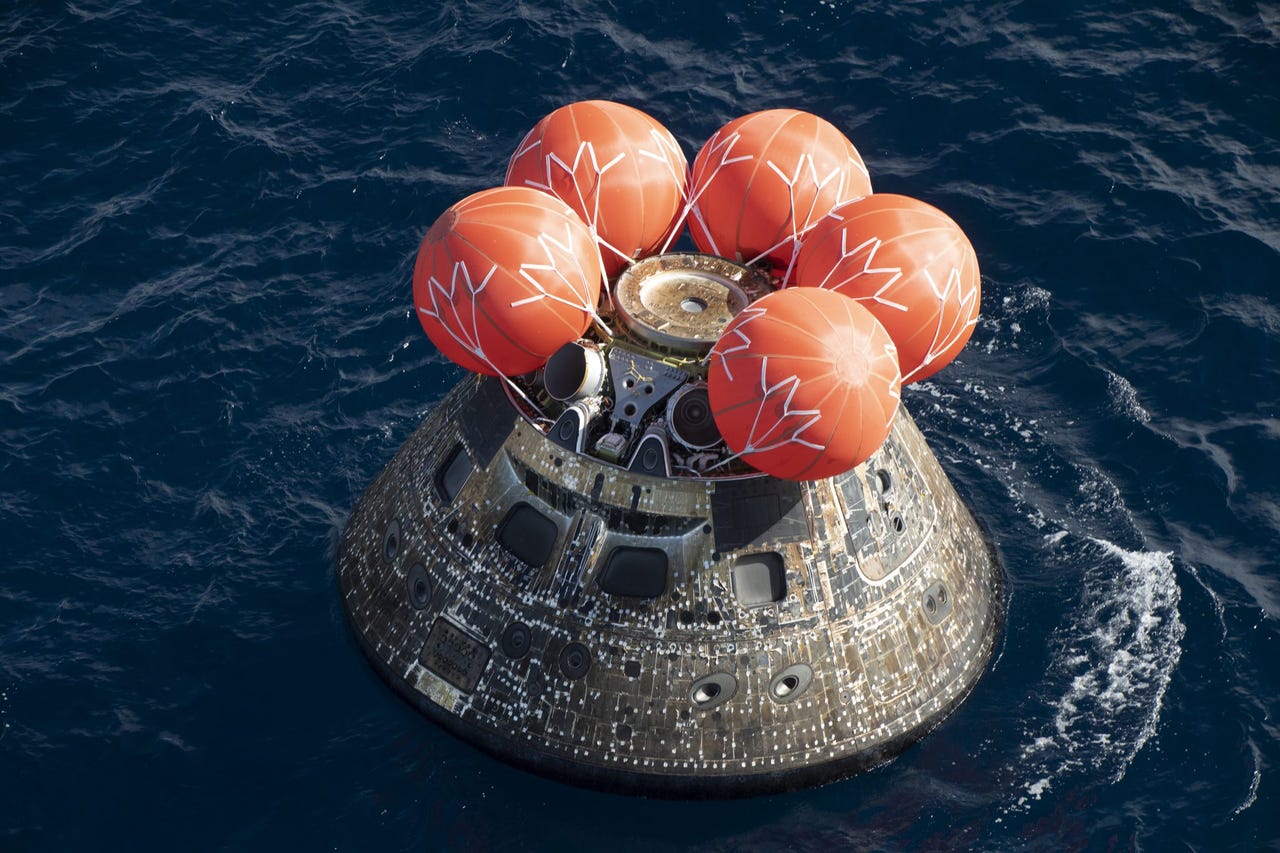Orion parachute splashdown completes Artemis I moon mission


NASA's Orion spacecraft for the Artemis I mission splashed down in the Pacific Ocean after a 25.5-day mission to the Moon.
The Artemis I mission spacecraft Orion has completed its parachute-assisted splashdown off the coast of Mexico. On Sunday, Orion's heat shield successfully withstood the extreme heat of re-entry to Earth's atmosphere as it plummeted at 24,500 miles per hour.
Orion splashed down in the Pacific Ocean, west of Baja California, at 9.40 am PST Sunday, about two hours earlier than expected, closing out the historic mission. The moment came 25.5 days after NASA's Space Launch System (SLS) finally lifted off on November 16 from NASA's Kennedy Space Center in Florida, following several aborted launches due to technical issues and storms.
Space
The mission around the Moon and back was a test run in deep space for when the Artemis II mission lifts off with astronauts onboard Orion.
Also: What is Artemis? Everything you need to know about NASA's new moon mission
The final milestone for Orion, which completed multiple powered burns and conserved more than enough propellant for the journey, was to see whether its heat shield could withstand the heat of a high-speed re-entry to Earth's atmosphere. The heat shield was exposed to temperatures about half as hot as the sun.
The other priority was retrieving Orion and its parachutes after splashdown – a part of the mission led by NASA's recovery team in conjunction with the US Navy.
"The splashdown of the Orion spacecraft – which occurred 50 years to the day of the Apollo 17 Moon landing – is the crowning achievement of Artemis I. From the launch of the world's most powerful rocket to the exceptional journey around the Moon and back to Earth, this flight test is a major step forward in the Artemis Generation of lunar exploration," said NASA administrator Bill Nelson.
"It wouldn't be possible without the incredible NASA team," Nelson continued. "For years, thousands of individuals have poured themselves into this mission, which is inspiring the world to work together to reach untouched cosmic shores. Today is a huge win for NASA, the United States, our international partners, and all of humanity."
Orion's return lunar flyby saw it come within 80 miles of the Moon and it travelled nearly 270,000 miles from Earth – more than 1,000 times farther than the International Space Station's orbit of Earth. The purpose was to stress test Orion without human crews. While in distant lunar orbit, Orion set a new record at 268,563 miles from Earth, surpassing the record distance set by the Apollo 13 mission in 1970.
NASA originally planned to land Orion off the coast of San Diego, but a cold front moving in the Southern California area caused forecasted light rain, wind and choppy seas, prompting NASA to move the targeted landing site south by 300 nautical miles.
Splashdown and retrieval were NASA's first and third mission priorities for Orion. The second is to demonstrate Orion's operational and flight modes. Part of this included NASA downlinking over 140GB of engineering and imagery data during the flight.
In the coming days, NASA and the Navy will bring Orion to shore, where technicians will offload the spacecraft and transfer it by truck back to the Kennedy Space Center.
At Kennedy, teams will open the hatch, retrieve data recorded onboard and unload its various payloads, including Commander Moonikin Campos, the space biology experiments, Snoopy, and the official flight kit. After this, NASA will test and analyze the capsule and its heat shield over the course of several months.
Also: Artemis mission: No astronauts on the Orion spaceship, but some unusual passengers
Future Artemis missions aim to establish a long-term lunar presence for scientific discovery and prepare for human exploration of Mars.
NASA is currently testing a CubeSat as part of the Capstone mission, which last month entered a special near-rectilinear halo orbit (NRHO) on which it intends to put the future Gateway space station to support Artemis crews. NASA selected the NRHO orbit because it needs Gateway's propellant to last at least 15 years, but also be close enough to the Moon.